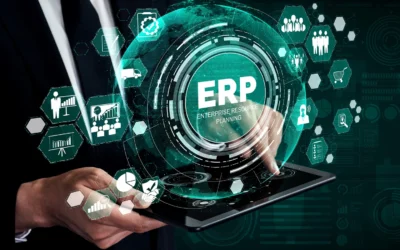
Connecting ERP and ECommerce: 10 Keys to Success
E-Commerce and ERP integration is a critical component of any successful business model. By integrating e-commerce and enterprise resource planning (ERP) systems, companies can dramatically improve customer experience, streamline their operations, and access important data in real-time. In this article, we’ll cover 10 must-haves for a successful e-commerce and ERP integration. From data synchronization to automated order fulfillment, these 10 features are essential for optimizing your business processes and driving profitability.
1. Automated Order Syncing
The ability to automatically sync orders between an E-Commerce platform and the ERP system allows businesses to save time and money by streamlining the ordering process. This type of synchronization allows orders to be seamlessly transferred between the two systems in real-time, eliminating the need for manual order entry. Additionally, this type of synchronization allows businesses to edit orders in real-time without having to manually enter the changes in both systems. This kind of automation helps to reduce errors and speed up the order fulfillment process.
2. Automated Inventory Syncing
This will help to avoid discrepancies between the two systems and ensure that customers are able to purchase the products they are interested in without any delays. The synchronization of the inventory levels should be done in a way that is efficient and cost effective. The process should also be secure and reliable in order to protect the data from being compromised. Additionally, it should be easy to maintain and configure, so that changes can be made quickly and easily.
3. Automated Item/SKU Syncing
Synchronizing SKU attributes between an E-Commerce platform and an ERP system in real-time can help to streamline business operations and reduce the time spent on manual data entry. This process automates the transfer of SKU information, such as price, description, quantity, and more, so that all systems have the same up-to-date information and no manual data entry is needed. This helps to ensure that customers have the most accurate and current information about the products they are viewing, and that the business’s financial records are always up-to-date.
4. Automated Payouts Syncing
With the help of an automated system, the details regarding payouts from an E-Commerce platform can be seamlessly integrated with an ERP system in real time. This allows for the efficient and accurate tracking of payments and makes the entire bank reconciliation process more streamlined. With this system in place, businesses can be sure that their payouts are always up-to-date and accurate. Additionally, it also makes it easier to identify discrepancies and take corrective measures as needed.
5. Multi-Location Support
This feature provides the ability to connect multiple e-commerce stores to one ERP platform like Xorosoft, allowing you to manage all of your sales and inventory data in one place. This enables businesses to have greater control over their operations, as well as provides better visibility into their sales and performance. It also allows for easier integration of data between different systems, reducing the need for manual data entry. Furthermore, it allows for automated updates of inventory and order data across all of your connected e-commerce stores and ERP system, ensuring that your data is always up-to-date.
6. Multi-Currency Support
The ability to support multiple currencies when syncing data between E-Commerce and the ERP system is a great feature for any business. This allows for a more efficient and accurate way to record, track, and report on business transactions that involve different currencies. With this feature, businesses can easily keep track of the different exchange rates and make sure that the correct amount is being recorded in the ERP system. This can help businesses save time and money, as well as gain better visibility into their financials. Additionally, it can help to reduce the risk of errors and fraud associated with multiple currencies.
7. Automated Refunds Syncing
Automatically syncing refunds and returns details between an E-Commerce system and an ERP system can be a great way to streamline operations and improve the customer experience. By syncing the two systems in real-time, you can ensure that any returns or refunds are immediately communicated to the ERP system and that any related orders are updated accordingly. This can help reduce costs associated with manual order entry and reduce the workload of customer service staff. Additionally, it can help improve customer satisfaction by providing customers with timely updates on order status, returns, and refunds.
8. Automated Fulfillment Syncing
This means that the fulfillment details between your e-commerce platform and ERP system will be automatically updated in real-time. This means that any changes made in the ERP system like Shipping charges, tracking numbers etc will be reflected in the E-commerce system in a timely manner, ensuring that all information is accurate and up-to-date. This feature helps to streamline processes and make sure that your business operations are running smoothly and efficiently.
9. Meta Fields Syncing
Meta fields are pieces of information that store additional data about an object. For example, meta fields associated with a product help to enhance the product description. They can be used to provide additional information about a product, such as its colour, size, or material. This helps customers make informed decisions about their purchase, as they can quickly and easily see the details that are most relevant to them. Meta fields are also useful for search engine optimization, as they provide search engines with more information about a product, which can help to improve its ranking in search results.
10. Automated Gift Card Syncing
Automatically syncing gift card details between E-Commerce and the ERP system in real-time is important because it ensures that all customer data is up-to-date and accurate, which is essential for providing a good customer experience. By having the two systems in sync, customers can be sure that their gift card details will be accurately reflected when they make a purchase, and that their payment information is secure. Additionally, having the two systems in sync helps streamline operations for the business, as it eliminates the need for manual data entry or data synchronization. This saves time and reduces the risk of human error.
Conclusion
By integrating e-commerce and ERP systems like Xorosoft, businesses can dramatically improve efficiency and customer experience, while also providing a secure platform for online transactions. With the 10 must-haves mentioned above, businesses can ensure that their integration is successful and that they are able to take advantage of the many benefits that come along with it. From automated order and inventory syncing to multi-currency support, these 10 features are essential for optimizing business processes and driving profitability.









